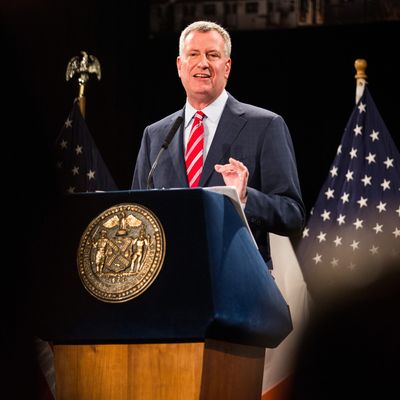
On the fireplace mantel in Bill de Blasio’s City Hall office — next to a framed New York magazine cover featuring the mayor and his family — is a photograph of American troops storming the beach during the Normandy invasion. He put it there for inspiration, de Blasio says — as a reminder to attempt big, bold undertakings.
Building 11,250 new units of affordable housing at the Sunnyside railyards in Queens certainly qualifies. There were several compelling proposals in de Blasio’s 2015 State of the City speech this morning — citywide ferry service; new living spaces for veterans, artists, and senior citizens; affordable housing mandated as part of any re-zoned sites. Many of de Blasio’s ideas were worthy and grounded in his vow to govern for the 99 percent; most come with significant uncertainties about definitions and costs.
But the Sunnyside vision was the largest idea, physically, and has already become the hottest, politically: About two hours after de Blasio exited the stage to the strains of Peter, Paul and Mary’s “If I Had a Hammer,” Governor Andrew Cuomo issued a statement declaring that the yards are important to the MTA and “not available for any other use in the near term.”
Maybe Cuomo is miffed that de Blasio didn’t play the Pete Seeger version of “Hammer.” More likely this is just the beginning of a protracted negotiation, with some fascinating political ripples. Cuomo, back in his 2012 State of the State address, floated the notion of replacing the Javits Center with a new $4 billion convention facility at Aqueduct racetrack. That plan collapsed within six months, when a Malaysian gambling company balked at paying for a major share of the project.
The scheme was revived in November, however, on the op-ed page of the Times, in a new form: Replace Javits with a convention center at Sunnyside Yards, plus 14,000 residential units, 50 percent of them “affordable.” Even more intriguing was the essay’s author — Dan Doctoroff, who’d been Mayor Michael Bloomberg’s forceful deputy mayor for economic development. Sunnyside has been on Doctoroff’s mind for a long time. It was a key location in his pitch to bring the 2024 Olympics to New York.
A middle-class-housing enclave at Sunnyside would be an indirect de Blasio answer to a more successful Doctoroff deal — the luxe Hudson Yards on Manhattan’s West Side. It would also be a nifty jab at the pals of Bloomberg who have been encouraging Doctoroff to run against de Blasio in 2017. (Pure, fantastical conspiracy theorizing: Did Doctoroff, knowing the state controls about one third of Sunnyside, run his op-ed proposal past the governor? Was the governor aware of the 2017 campaign chatter and didn’t mind making mischief for de Blasio? Nah, probably not.)
The mayor’s team has been in talks with Amtrak, which controls 113 of Sunnyside’s 200 acres and is always desperate for cash. What might help de Blasio’s odds even more, though, is allowing Cuomo to take most of the credit for creating housing at Sunnyside — kind of like what happened last year with pre-kindergarten.





























